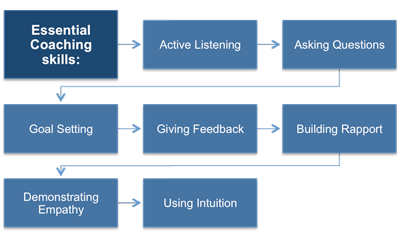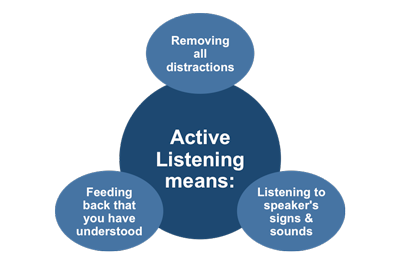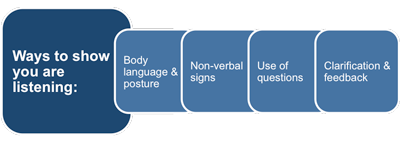Coaching and Active Listening
This skill underpins the whole coaching process and you will not be able to coach people without it. Active listening requires you to put your own concerns, attitudes, and ideas to one side while you listen to your coachee. This demonstrates to that individual that you are giving them your undivided attention.
 |
You need to hear exactly what is being said to you so that you can use the coachee's knowledge to give you an understanding of the performance issue you aim to address through the coaching process.
By truly listening you are able to form questions that aid the coachee's thinking process.
 |
So what does active listening entail? The essence of this skill is your ability to prevent distractions breaking your concentration during the communication. Without these distractions you hear 'all' that your coachee is saying. You are able to observe all the conscious and unconscious signs displayed, enabling you to discern the true meaning behind the spoken words.
As with communication, active listening is a two-way process and the final element of this competency is your ability to feed back to the coachee that you have comprehended what they have really said. By utilizing such techniques you will begin to develop rapport and empathy with the individual.
Others will use the same methods as you to assess how well they are being listened to. An obvious way they can detect your level of attention is through studying your body language and posture. The amount of eye contact you have with the coachee, your use of non-verbal signs, such as a nod or a smile, and verbal signals such as uttering a 'Uh huh' or 'Mmmm' whilst they are speaking are just some of the ways people assess how well they are being heard.
Phrases you use during the exchange will also communicate how well you are listening. They also demonstrate that you are attentive to and accepting of what the coachee is telling you.
For example,
Attentive - 'Can you tell me what you did when that happened?'
Acceptance - 'That's an interesting perspective on what happened. What made you think that?'
This technique leaves the coachee in no doubt that you are giving them your full attention and sends a powerful double message - firstly, that you are there to support them in whatever they are doing; and secondly, that you are paying attention and expect them to follow through on any commitments they make.
It is essential that you as a coach curtail any natural tendency you may have to rush in with suggestions or solutions. If you do not do this you will be unable to avoid acknowledging your own emotions during the communication. You need to allow the coachee to present the whole picture so that they expose the level of their knowledge and the extent of their ideas on how to address the issue facing them.
 |
By allowing several seconds of silence before you ask a question or give feedback you will ensure that the coachee has said all they want to.
You can also indicate your attentiveness by accurately paraphrasing the coachee's words into a statement that communicates your impartiality and comprehension. This also enables you to demonstrate that you have understood their explanation of the issue.
Active listening will also enable you to give reasoned and constructive feedback during the coaching process. This behavior has additional benefits in that your coachee will feel that their views and interpretations of events are valued, encouraging them to explore ideas and their thinking in order to attain their goal.
To be an effective coach you must show that you are genuinely interested in the other person and what they have to say, and want to help them develop their competencies to improve performance. A significant way to achieve this is through the use of questioning, which is discussed in the next section.
You may also be interested in:
Management Coaching Skills and Models | Asking Questions in a Coaching Session | Coaching and Goal-setting | Giving Feedback to the Coachee | Building Rapport with the Coachee | Demonstrating Empathy and Using Intuition in Coaching | Coaching Models and 'The Inner Game' | The GROW Coaching Model | The TGROW Coaching Model | The OSKAR Coaching Model | Organizational Barriers to Coaching.



